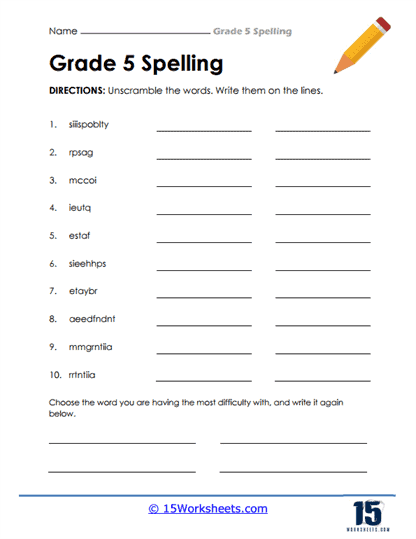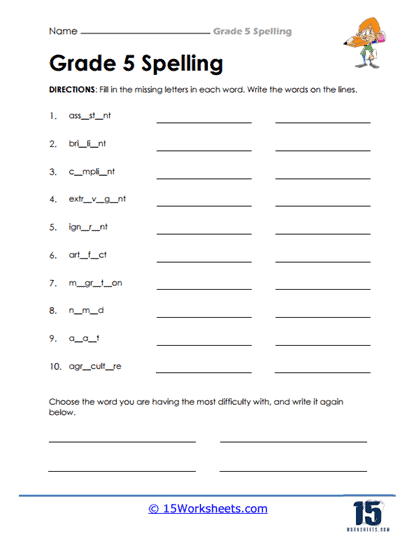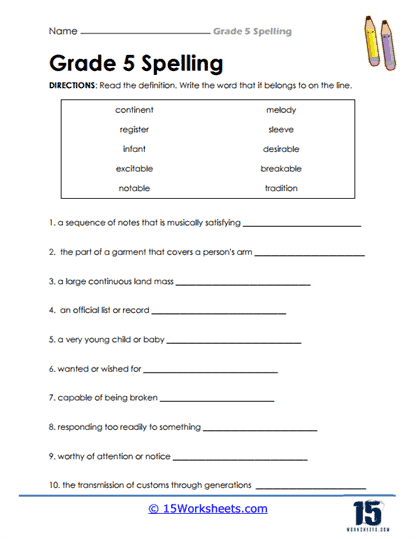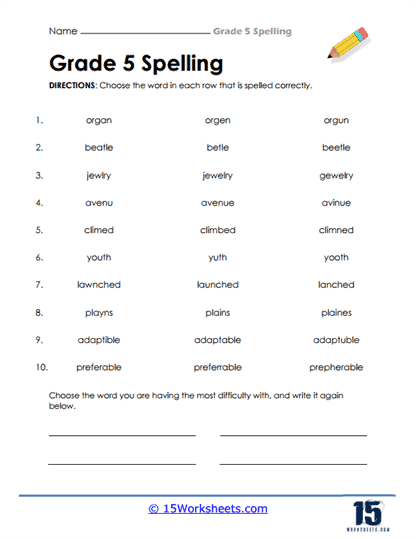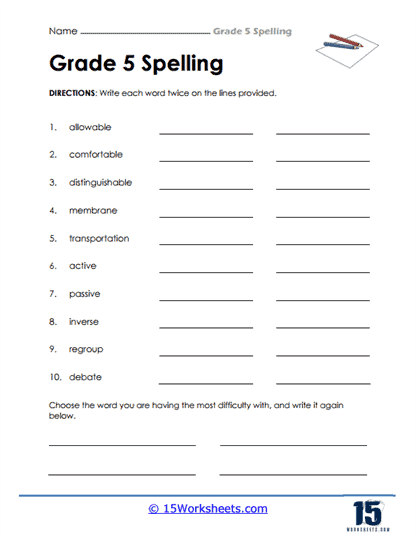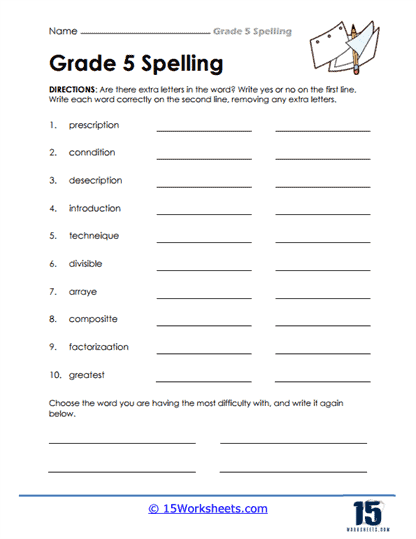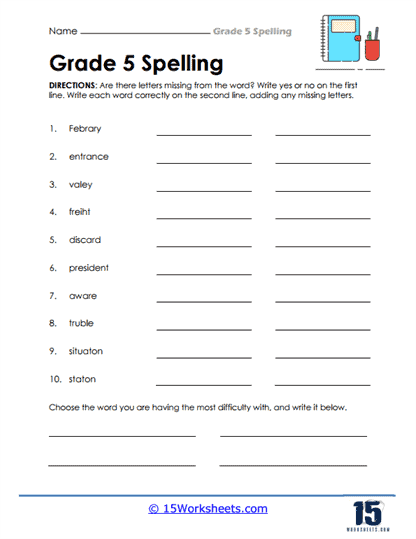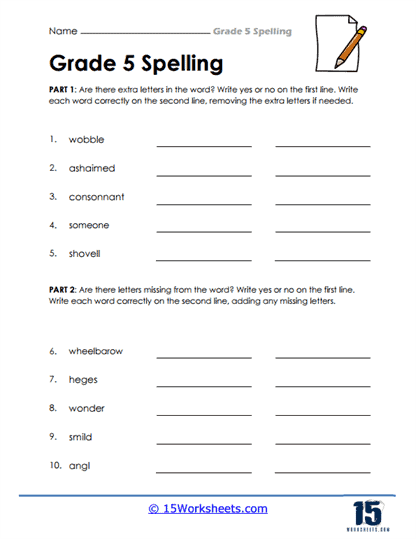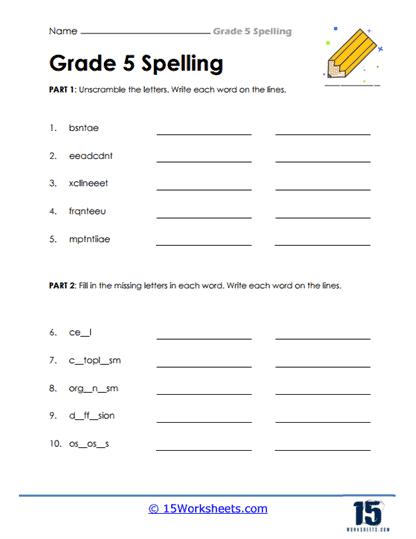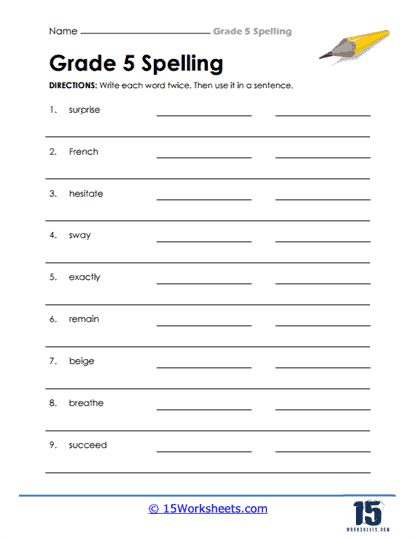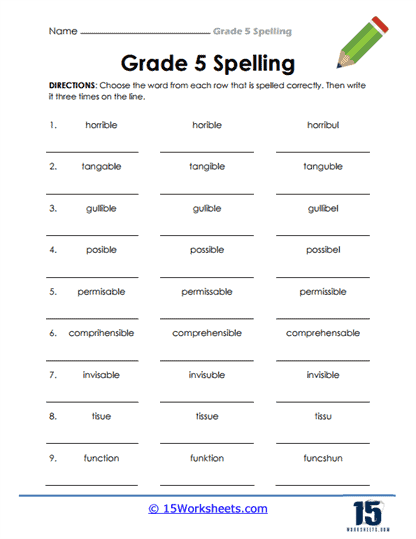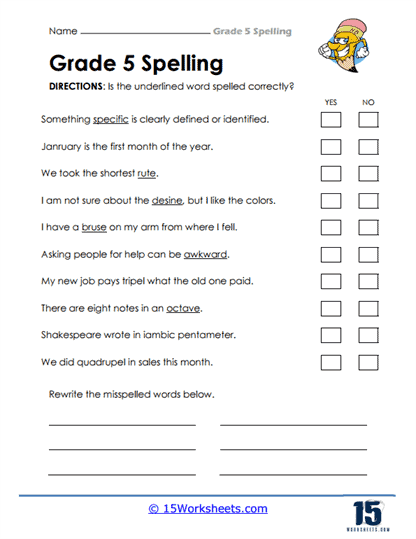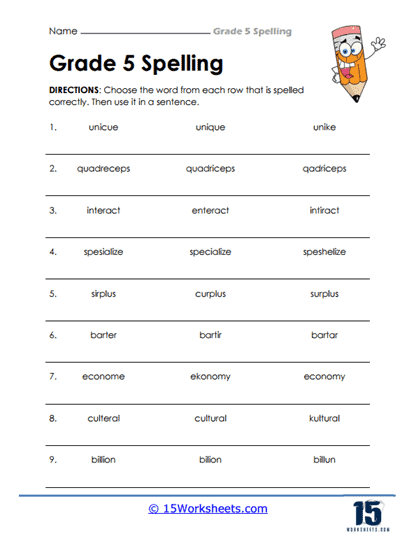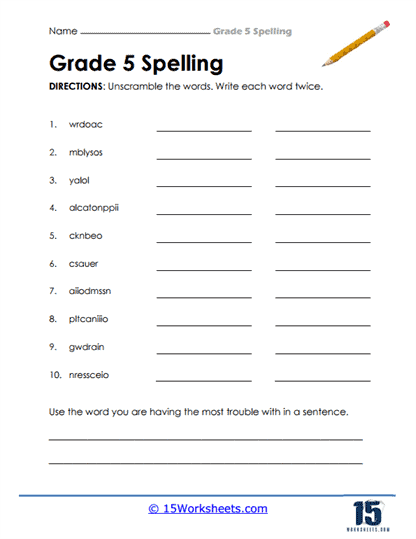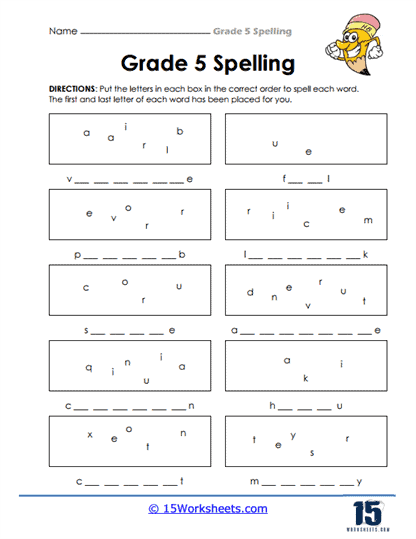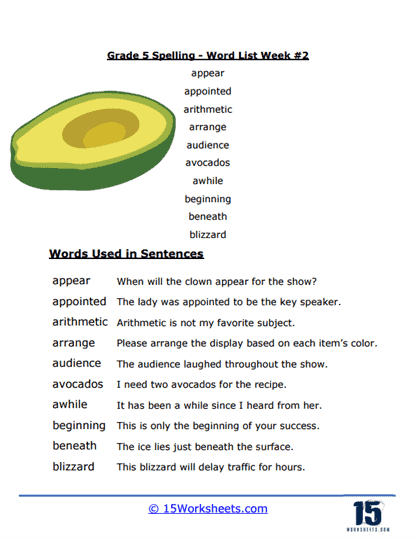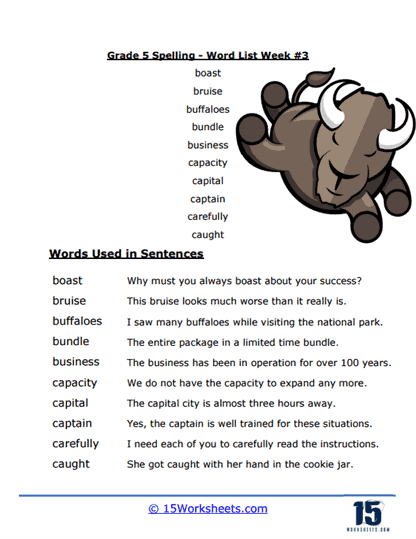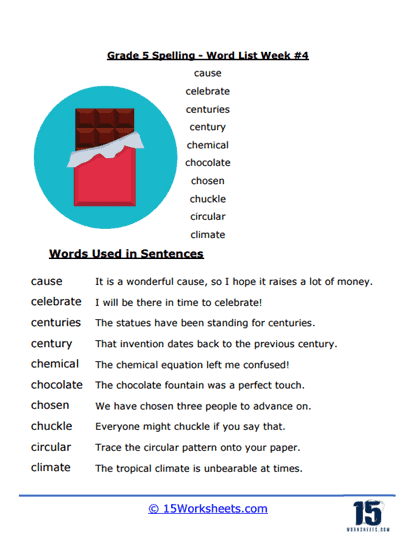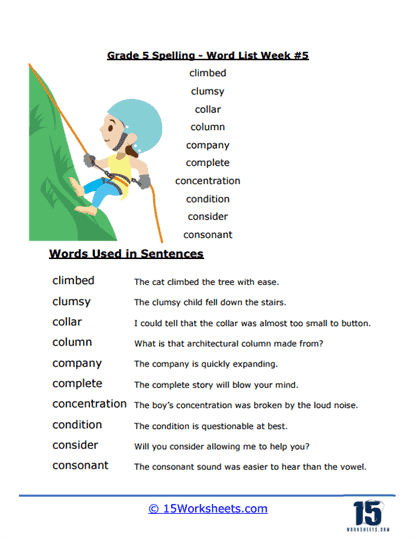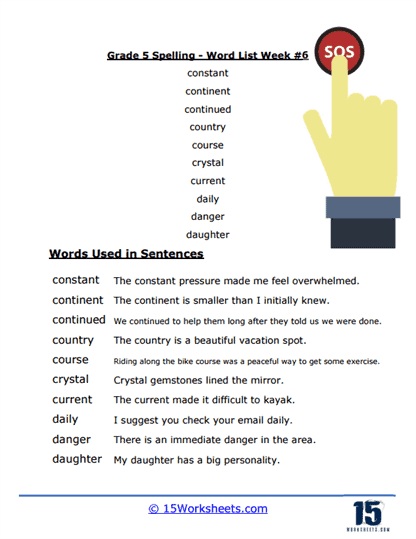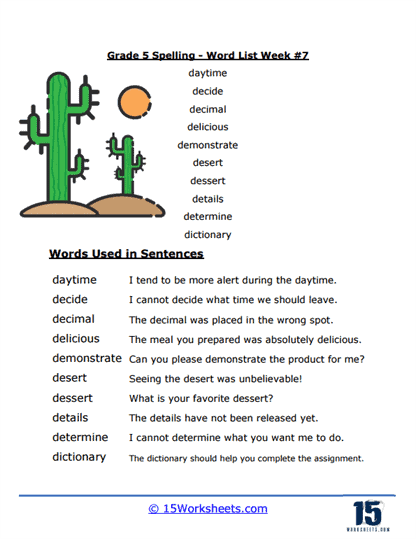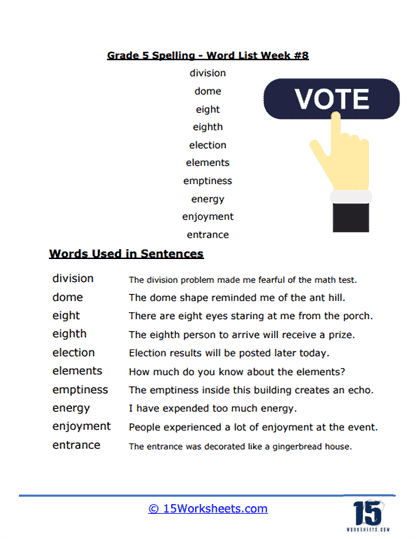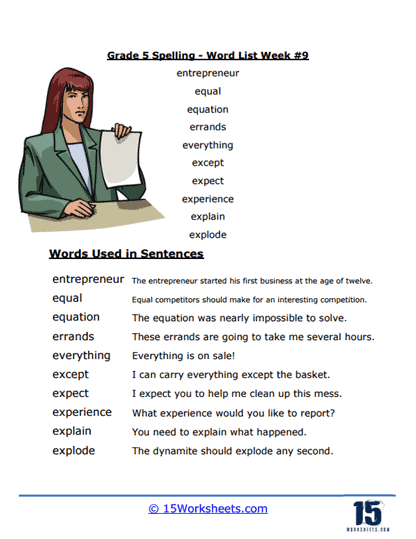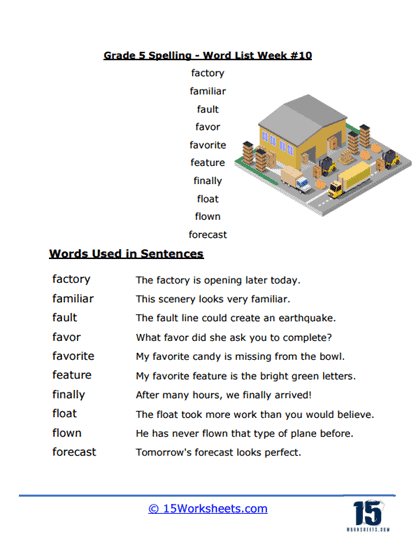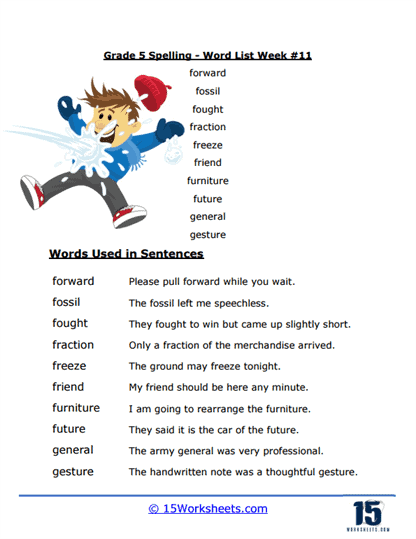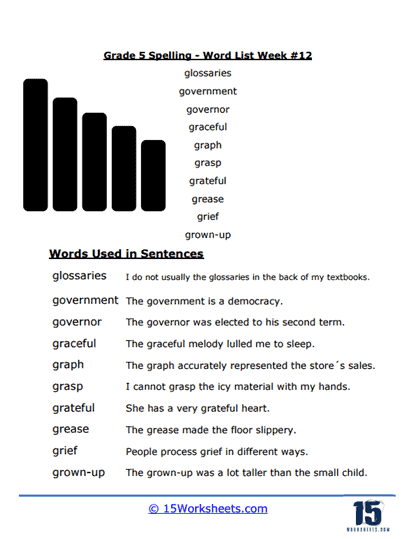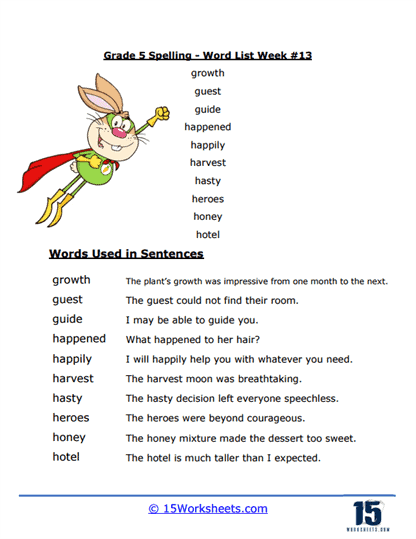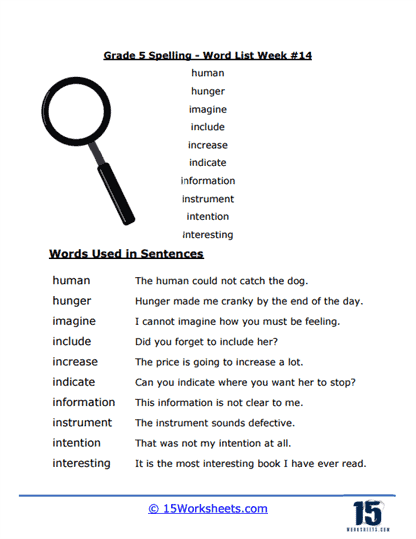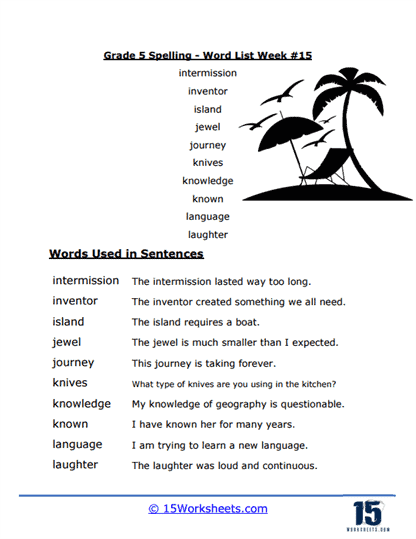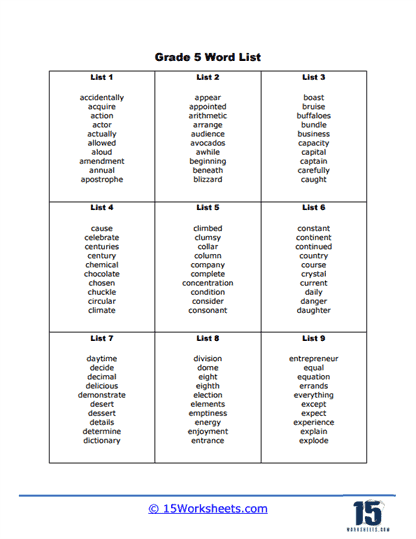5th Grade Spelling Words Worksheets
All About These Worksheets
These worksheets can help students at the 5th-grade level improve their spelling skills. They are tailored to align with the academic standards and language arts curriculum for this grade level, focusing on challenging vocabulary, patterns in spelling, and the correct use of more complex words. The exercises found on these worksheets aim to enhance students’ spelling abilities while also contributing to their overall reading, writing, and comprehension skills. They are often used in classrooms, tutoring settings, or for extra practice at home.
They can be super at helping students build a stronger foundation in language arts. At the 5th-grade level, students are transitioning from basic spelling patterns to more advanced word structures. These worksheets challenge them to recognize and apply spelling rules, such as prefixes, suffixes, and vowel patterns. By mastering these skills, students can enhance their ability to write with accuracy and clarity. Furthermore, consistent spelling practice improves reading comprehension, as students are better equipped to recognize and understand new words in context. By improving spelling, students also develop better communication skills, as accurate spelling is essential for clear written expression.
A variety of exercises can be found on our 5th grade spelling worksheets, each targeting specific aspects of spelling and language use. One common type of exercise is the word list practice, where students are given a list of words to memorize and practice spelling. These lists often include words with similar patterns, such as those with silent letters (e.g., “knight” and “thought”) or words with specific suffixes or prefixes (e.g., “unhappy,” “refresh”). The goal is to help students identify and internalize these patterns to use them correctly in future writing tasks.
Another common exercise is fill-in-the-blanks or sentence completion activities. In these tasks, students are required to fill in missing words in sentences or paragraphs with the correct spelling from a provided list or based on contextual clues. These exercises encourage students to not only spell correctly but also understand how words fit meaningfully into a broader context.
Crossword puzzles and word searches are also frequently included in spelling worksheets, adding a fun and engaging element to learning. These activities help students to practice their spelling in a way that reinforces memory recall, all while engaging in problem-solving. Additionally, these puzzles can sometimes incorporate definitions, prompting students to connect the spelling of words with their meanings.
Spelling rule practice is another important component of 5th-grade worksheets. Students may be tasked with recognizing and applying spelling rules such as dropping the final “e” before adding a suffix (e.g., “hope” becomes “hoping”), changing “y” to “i” before adding endings like “-es” (e.g., “baby” becomes “babies”), or understanding when to double consonants in words. These exercises help students internalize common spelling rules that are applicable across a range of words.
Many worksheets include proofreading tasks, where students must find and correct misspelled words within sentences or short paragraphs. This helps them to sharpen their editing skills, which is a crucial part of writing. Proofreading exercises develop students’ ability to recognize errors and understand how spelling affects overall writing quality.
What is a Common 5th Grade Spelling Curriculum?
At this level, students are expected to move beyond the basic words they have learned in earlier grades and engage with more complex and challenging vocabulary. The curriculum focuses on helping students understand the intricacies of the English language, including spelling patterns, rules, and word meanings, all of which are critical for building a strong foundation in both reading and writing. While specific content may vary depending on the educational standards of a particular school or district, the overarching goals remain the same: to enhance spelling proficiency, boost vocabulary, and improve language skills that will serve students as they transition to middle school.
Vocabulary Expansion
One of the main goals of a 5th-grade spelling curriculum is to introduce students to a broader and more advanced set of vocabulary words. At this stage, students encounter terms from a variety of subjects, such as science, social studies, and literature. For example, students might learn words like “photosynthesis” in science or “democracy” in social studies. These subject-specific words are not only valuable for improving spelling but also play a crucial role in boosting students’ comprehension and overall academic performance. Expanding their vocabulary helps students to better understand reading materials across different subjects, while also giving them the tools to express more complex ideas in writing.
In addition to subject-specific vocabulary, 5th graders are also exposed to a wider range of descriptive words and terms used in everyday life. Words like “exaggerate,” “invisible,” and “declaration” may be included in spelling lists to challenge students to not only spell these words correctly but also understand their meanings and use them in context. Through consistent practice with such vocabulary, students can become more adept at identifying and using complex words in their reading and writing, significantly enhancing their overall language skills.
Spelling Patterns and Rules
In 5th grade, students revisit and build upon the spelling patterns and rules they have learned in earlier years. Concepts such as vowel teams, consonant blends, and syllable patterns are reinforced, but the curriculum also introduces more complex spelling patterns and exceptions. For instance, students may review patterns like “ie” in words like “believe” or “ie before e except after c,” while also tackling irregular spellings, such as silent letters in words like “knight” or “wrist.”
Understanding these patterns is essential for students as they learn to decode unfamiliar words and apply logical spelling strategies. For example, a common rule might involve dropping the final “e” when adding a suffix, as in “care” becoming “caring.” These patterns give students a framework to approach words they may not have encountered before, empowering them to make educated guesses about how to spell unfamiliar words. By internalizing these rules, students become more confident and accurate spellers.
Prefixes, Suffixes, and Root Words
Breaking down words into their components—prefixes, suffixes, and root words—is another central feature of a 5th-grade spelling curriculum. Students learn that many words are built from common roots, particularly those derived from Latin and Greek. For example, the root word “dict” means to speak, which can be found in words like “predict,” “dictate,” and “contradict.” Learning these roots helps students not only with spelling but also with understanding the meaning of words.
Similarly, students are introduced to a wide range of prefixes and suffixes. A prefix like “un-,” meaning “not,” can change the meaning of a word entirely, as in “unhappy” or “unfinished.” Suffixes such as “-ful” and “-less” can turn a noun into an adjective, as in “hopeful” or “hopeless.” Understanding how to manipulate these word parts helps students gain a deeper comprehension of the English language, making it easier to spell and understand new words.
Homophones and Homographs
Homophones (words that sound alike but have different spellings and meanings) and homographs (words that are spelled the same but have different meanings) are challenging for many 5th graders, but mastering these is a vital part of becoming a skilled speller. Words like “their,” “there,” and “they’re” can confuse students, but by focusing on the differences in meaning and context, students can learn to use these words correctly. Similarly, homographs such as “lead” (to guide) and “lead” (a type of metal) teach students to pay attention to context and pronunciation.
Incorporating homophones and homographs into the curriculum not only enhances spelling skills but also helps students improve their reading comprehension and writing accuracy. By learning to recognize these tricky words and their uses, students avoid common spelling errors and misunderstandings in their written communication.
Word Origins and Etymology
Introducing students to word origins and etymology helps them appreciate the history and structure of the words they encounter. Many English words come from other languages, particularly Latin, Greek, and Old English. For example, the word “telephone” comes from the Greek words “tele,” meaning far, and “phone,” meaning sound. Understanding these origins gives students insights into the meaning of words, making them easier to spell and remember.
Etymology lessons can be fascinating for students, as they reveal the rich history of language and help students make connections between words. For example, learning that “astro” means “star” can help students spell and understand words like “astronomy” and “astrophysics.” By exploring word origins, students expand their knowledge of language and deepen their appreciation for how words are constructed.
Synonyms, Antonyms, and Shades of Meaning
Another important aspect of a 5th-grade spelling curriculum is teaching students about synonyms, antonyms, and shades of meaning. This expands their understanding of words by showing them how words can have similar (synonyms) or opposite (antonyms) meanings. For instance, the word “happy” has synonyms like “joyful” and “content,” while its antonym is “sad.” Teaching these concepts helps students understand nuances in meaning, which improves both their reading comprehension and writing.
By exploring different shades of meaning, students can select the most precise word to convey their thoughts. For example, while “angry” and “furious” are synonyms, “furious” conveys a stronger sense of emotion. Learning these distinctions helps students become more effective communicators and enhances their ability to write with clarity and precision.
Spelling Strategies
To help students become independent spellers, a 5th-grade spelling curriculum encourages them to use various spelling strategies. These might include sounding out words, using mnemonic devices, or applying spelling rules and patterns to unfamiliar words. Mnemonics, for example, are memory aids that help students remember tricky spellings. A common example is “i before e, except after c,” which helps students spell words like “receive” and “believe.”
Teaching students how to break down words into syllables, or use visualizing techniques, also reinforces their ability to spell words correctly. By equipping students with these strategies, the curriculum gives them tools to approach new and unfamiliar words with confidence.
Contextual Usage
Spelling doesn’t happen in isolation. One of the goals of a 5th-grade spelling curriculum is to ensure that students can use new vocabulary words in context. Exercises that ask students to write sentences using their spelling words or to complete fill-in-the-blank activities with the correct word help them practice not only spelling but also contextual understanding.
By encouraging students to integrate their new vocabulary into their writing, teachers help them reinforce both spelling accuracy and the practical application of words. This, in turn, improves their reading comprehension as students encounter these words in books and articles. The ability to understand and use words in context is a critical skill that serves students well throughout their academic journey.
A 5th-grade spelling curriculum aims to strengthen students’ spelling skills, increase their vocabulary, and enhance their overall language proficiency, preparing them for more advanced language arts concepts in middle school and beyond. Teachers and parents can use various resources, including spelling worksheets, games, and activities, to support and reinforce the curriculum.

